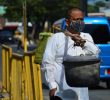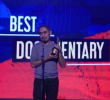DAVAO CITY – Lack of food and landlessness for many tribes may downplay the joyous air of this year’s holding of the Kadayawan fruit harvest festival, as a tribal orgfanization appeal for better focus on the current marginalization of the tribes than for its tourism value alone.
Seventy-six years old Monico Cayog, a Tagabawa-Bagobo from Davao del Sur, and leader of the Mindanao indigenous peoples’ confederation Kalumaran, said the Kadayawan celebration that shoud greet a bountiful harvest, now comes with sadness.
“I honestly don’t feel joyous about this Kadayawan,” Cayog told Davao Today in an interview the day the city’s 29th Kadayawan Festival opened on Monday.
Cayog said that the Kadayawan has its roots from his Bagobo heritage that signify celebration of harvests, but now his and other lumad communities are suffering from lack of food and support.
“Kadayawan is a Bagobo word that means happiness. It’s a time our communities gather after harvest time, to thank the gods for the harvest. We celebrate through feasts, and with songs and dance played with our instruments,” he said.
Not only was Kadayawan a celebration of harvest, he said it was also a “celebration of peace in the villages.”
But now he said the festival tend to focus on the traditional dances and costumes for tourist attractions, but people forget the reality that indigenous tribes have been one of the most marginalized and “militarized”.
“For those who lost their lands, or their families to plantations and large-scale mining, would they be celebrating like those dancing in the streets?” he asked.
“The true celebration of Kadayawan can only happen if lumads find true peace in their communities. No more big companies or army encroaching our ancestral domain,” Cayog said.
The city’s Kadayawan Festival is known for the “indak-indak sa kadalanan” or street dancing, which is an inter-regional indigenous dance competition among schools. Other activities with an indigenous tone include song competition with ethnic themes, beauty contests participated by Davao’s ten indigenous and Moro tribes, and indigenous sports.
Anthropologist Myfel Paluga from the University of the Philippines Mindanao, said that the Kadayawan, if handled in the right way by Davao’s vibrant sectors, could serve as an eye-opener and support to the indigenous peoples in Davao Region.
“Just like festivals here and elsewhere that showcase the local culture, ours is a showcase of IP [indigenous peoples] and Moro traditions,” he said. “For that it is commendable that festivals provide a venue for people especially outside of Davao to witness for the first time the cultures of the Lumad and Moro people in Davao.”
What is lacking, he said, is that festivals “freeze the lumads to just merely displaying costumes, heritage and traditions, isolating the lumads and viewers alike from the realities of their continuing struggles”.
“To give respect to the lumads, festivals should also show the other side of reality,” he said.
That reality he said should be about “lumads who are are victims of development conflict, who sometimes become pawns of big players that fight fellow lumads.”
Paluga said there should not just be celebration, but advocacy to bridge the people’s appreciation towards action to help sustain the lumad and Moro cultures.
He suggests that festival activities must have parallel venues to educate people on the plight of the lumads.
“Let’s make the festival more participatory, that will include the inputs of people’s organizations and community workers. The audience should also know that there should be empowerment of lumad communities, such as efforts of sectors to put up schools, livelihood to strenghten their capacity to continue their cultures,” he said.
Paluga said cultural artists, that he called “cultural mediators”, would have a crucial role in “re-staging” the indigenous cultures to non-indigenous audience. Such festival, like the Kadayawan, should help strenghten the cultural roots of the city.
“For once in a year, the indigenous become the center of our attention. Let’s make the festival more vibrant and participatory.” (davaotoday.com)
29th Kadayawan, culture, davao, davao city, festive, Festivities, Food, kadayawan, Kadayawan Meaning, lack, lack of food in kadayawan, Lifestyle, manobo, Mindanao, of, Philippines\, Tribal









